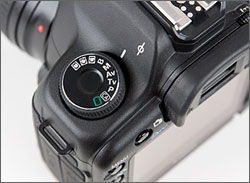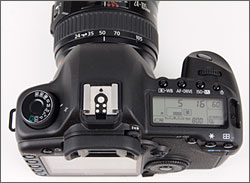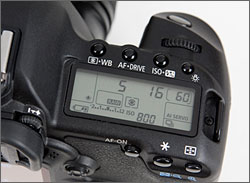Canon EOS 5D Mark II Features
There’s a lot more to the Canon EOS 5D Mark II than the full frame 21.1-megapixel CMOS sensor, 1080p HD video and 3-inch 920k-dot LCD display. First and possibly most important, there’s the new Canon DIGIC IV image processor. The 21.1-megapixel sensor captures huge files. The RAW files from our studio tests range in size from about 24MB all the way up to almost 40MB! The 5D Mk II needs some serious processing power to handle those files – especially at the 3.9 frames-per-second high-speed capture rate. That processing power is also critical for video and makes the 30 frames-per-second 1080p video possible.
The 5D Mark II has Live View, of course. Live View is a standard feature on digital SLRs now and Canon has added a dedicated Live View button to the left of the viewfinder. The video mode is actually sort of a subset of Live View. To record video, you enable Live View and then press the Set button in the middle of the Quick Control Dial on the back of the camera. There is no auto focus in the video mode so it’s best to switch to manual focus and prefocus your shot. Initially, video exposure was automatic with exposure compensation but a recent firmware update made manual exposure control during video capture possible. Video sound with the built-in microphone is mono but there’s a microphone terminal on the left side of the camera that can accommodate an external stereo microphone.
 The 5D Mark II was designed for serious photographers and the exposure options reflect that. It has program (P), aperture priority (Av), shutter priority (Tv), manual (M), bulb (B), full auto and the Creative Auto mode (CA), which allows a little more control than full auto – but it doesn’t offer any scene modes. It also has three custom “Camera User” settings that can be programmed with pretty much any settings you want. The sensitivity range is ISO 100 to 6400, expandable to ISO 50 and ISO 25,600. The maximum shutter speed is 1/8000 second and the flash syncs at a respectable 1/200th second.
The 5D Mark II was designed for serious photographers and the exposure options reflect that. It has program (P), aperture priority (Av), shutter priority (Tv), manual (M), bulb (B), full auto and the Creative Auto mode (CA), which allows a little more control than full auto – but it doesn’t offer any scene modes. It also has three custom “Camera User” settings that can be programmed with pretty much any settings you want. The sensitivity range is ISO 100 to 6400, expandable to ISO 50 and ISO 25,600. The maximum shutter speed is 1/8000 second and the flash syncs at a respectable 1/200th second.
The auto focus system has nine AF points arranged in an elongated, horizontal diamond pattern. For the most part the auto focus system was handed down from the original EOS 5D. The speed of the auto focus has been improved in the 5D Mark II and the camera now also offers AF Microadjustment in the auto focus custom function menu. Other than that it’s pretty much the same as the previous 5D. If auto focus speed and accuracy are a top priority, the EOS 40D or 50D should offer better performance because the auto focus system in the 40D is newer and all nine points are the more sensitive cross-type.
One feature that’s easy to miss or take for granted is the huge optical viewfinder. If you’re used to an APS-C sensor camera the difference is immediately obvious. The crop sensor cameras have smaller viewfinders to cover the smaller area of the APS-C sensor, which is approximately half the size of the 5D Mk II’s full frame sensor. The larger viewfinder means you see more detail with less effort. That makes it easier to compose, and professional photographers or others doing lots of shooting should feel less fatigue after a long day behind the camera.
I can’t talk about the Canon EOS 5D Mark II without going into the pros and cons of shooting with a full-frame sensor. A lot of photographers seem to believe that a full-frame sensor automatically means a better camera. The reality is the full-frame sensor has some benefits and some drawbacks. The main benefits are better image quality because of larger pixels, and better shallow depth-of-field control. Shallower depth-of-field will benefit portrait and wedding photographers who use large apertures to soften the backgrounds in their photos. Other photographers may find they actually prefer the increased depth-of-field a crop-sensor camera offers. Another common argument for full-frame cameras is they allow real wide-angle shooting. Lack of wide-angle lenses for crop-sensor digital SLRs used to be a very real problem. But that’s not the case anymore. Canon makes a great super-wide zoom for APS-C bodies (as do Nikon, Pentax, Olympus, and Sony) and third-party lens makers offer a whole bunch more. So you don’t have to go full-frame anymore if you want to shoot really wide.
Canon EOS 5D Mark II Design
The 5D Mark II body is built around a stainless steel chassis with internal magnesium covers. It also has improved weather and dust sealing compared to the original 5D. Canon claims the weather-sealing is nearly equal to the EOS 1N 35mm film camera, their top-of-the line camera body in the Nineties. If you’ve used a high-end Canon SLR – film or digital – you should be able to pick up the 5D Mark II and start shooting right away. The most obvious change since the original 5D is the huge 3-inch LCD on the back of the camera. It’s half an inch bigger than the LCD on the original 5D and it has 920,000 dots, compared to the original 5D’s 320,000 dots. The trash button below the LCD on the old 5D has been moved to the left to make room for the larger LCD and there’s also a dedicated Picture Style button. The upper right side of the camera has a third, dedicated AF-On button instead of just the two zoom / Custom Function buttons.
 |
 |
|
| Canon EOS 5D Mark II top controls and lcd | ||
![]()
The top right of the camera has an exposure information LCD that displays shutter speed, aperture, ISO, image quality, number of exposures left, battery level, white balance, etc. In front of the top LCD and within easy reach of the index finger are three dual-purpose buttons for white balance/metering, AF/drive, ISO/flash exposure compensation and a fourth button that turns on a backlight for the display. Press any of the dual-purpose buttons and you can use the Main Dial (index finger) and the Quick Control Dial (thumb) to control the two functions. For anyone who isn’t familiar with Canon’s professional SLRs, the Main Dial and Quick Control Dial control shutter speed and aperture, respectively. It’s a wonderfully intuitive and comfortable exposure control system. The proof is Canon hasn’t seen fit to change it since they introduced it with the original EOS 1 35mm SLR in 1989.
next page – Canon EOS 5D Mark II Camera Experience >>
|



A few remarks about your review. You say it is possible to shoot in the dark with the Mark II and a 24-105 f4 at ISO 3200. That may be true but people should consider that f4 is three stops slower than 1.4 wich means you can shoot using the same shutter speed at ISO 400. You can do that with any camera.
And it depends on your subjects of course but flash (or extra lights) will always be needed. Maybe not to light the whole picture but certainly to change the light balance within the picture.
Finally, you may think it is heavy but it is actually 20% lighter than the D700. So you can also say it is relatively light.
Amedi-
Thanks for commenting. Very true that the 5D Mk II is lighter than some other pro cameras. That’s a good perspective to add. It’s definitely lighter than the Canon EOS-1D cameras. Personally, I am always trying to go as light as possible when I’m in the backcountry. And that’s why I said the 5D Mk II is heavy. It’s also a much coveted camera for people just starting to work as pro photographers. And some of those people will be surprised at the weight. But if you’re workiing in the studio or on the street the weight shouldn’t be an issue. It’s only an issue for me when I’m on my mountain bike.
Regarding “shooting in the dark” – I may have been a little overexuberant there
It’s true that a faster lens will always offer better image quality because it collects more light. But the flexibility of the 24-10f f/4L zoom is really, really nice. You can do almost anything with it. And the high ISO performance of the 5D Mk II is so good that I don’t think it’s a big deal to shoot at ISO 800 or even 1600. So you’re absolutely right about faster lenses. You’ll get better image quality if you use an f/1.4 prime. But it’s not going to be nearly as versatile as the 24-105mm f/4L or another reasonably fast zoom.
Amedi – shooting with f1.4 – good luck! Depth of field is limited to the extend of sharp eyes/blurry nose or the opposite, if shooting a portrait, and forget about group of people. Unless you really need a very special – featured picture, I can’t imagine using 1.4 for practical purposes.
Photo-John – sorry, faster lens does not offer a better image quality, it’s always much softer at the wide end (maximum aperture), but what it can do is to allow faster autofocus, brighter viewfinder and sometimes can “save the day” in a really dark environment, at the price of shallow depth of field, unless this is an intended effect. 1.4 prime and 24-105 have very similar image quality at 5.6 and higher (resolution wise). I do have some primes, but unless I need it for really close micro, zooms are much more practical…
Canon just announced the EOS 7D, an APS-C brother to the EOS 5D Mk II. Note that I didn’t say “little” brother. That’s because the EOS 7D offers a lot of benefits over the 5D Mk II, including faster frame rate, better AF and more video options. Learn more in our preview article:
Canon EOS 7D Digital SLR Preview >>
Shooting at 1.4 is seldom practical, unless you a quite a distance from the subject. Forget about shooting this wide for any wide subject capturing needs. The 24-105L is an exceptional lens, no question. Coupled with the 5DMarkII’s excellent ISO performance, you have an excellent general purpose combination.
The assertion that 2.8 glass yields better image quality is fundamentally untrue. Wider glass is faster, and capable of gathering more light, but this often comes at the penalty agianst image quality. It is the higher class zooms(L glass) and primes that are engineered better to deal with the inherent challenges of wide aperture glass. There are plenty of vendors that offer 2.8 glass that is clearly inferior to Canon L 2.8 glass.
The Canon 7D is excellent, but comes up short in comparison to the 5D MarkII where it is most important; Image quality and high iso performance. So it just depends on what features are most important to you. I own a 17-40 f4L, and would want to give up my true wide focal length for the sake of a much smaller 1.6 crop. But that’s just me.
I have an eos 5d mk 1 and have decided to wait for a 5d mk3 before I upgrade, due to the dated 9 point focus layout of the 5d mk11. To get my tech fix, I have purchased the eos 7d as my second camera which should keep me going in the meantime. Canon – please upgrade the old 9 point focus system on the 5d mk2 and I’ll buy one at once… honest!
http://www.jackcutting.com